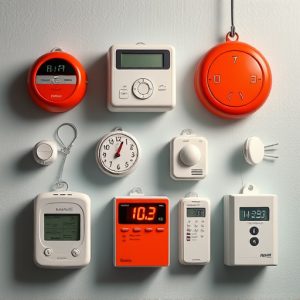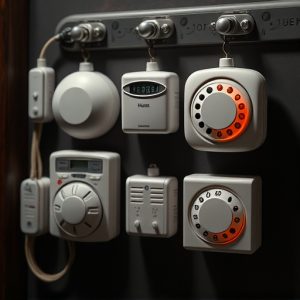Personal Alarm Distance Range Comparison: Unlocking Safety’s Boundaries
Mobile panic button alarm systems enhance personal safety with discreet, portable distress signals t…….
Mobile panic button alarm systems enhance personal safety with discreet, portable distress signals that use cellular networks or GPS to quickly alert emergency contacts within a defined Personal Alarm Distance Range. This range varies by model, from 30-50 meters for everyday carry to over 1 kilometer for outdoor and remote use. Advanced features like GPS tracking, automatic fall detection, and customizable distance ranges ensure tailored protection for diverse activities. When choosing, compare systems based on this Personal Alarm Distance Range Comparison and connectivity options for optimal coverage and response times.
In today’s world, personal safety is paramount. Mobile panic button alarm systems offer a revolutionary solution for individuals seeking immediate assistance in emergency situations. This article delves into the intricacies of these life-saving devices, exploring key components, functionality, and the critical aspect of personal alarm distance range. We provide a comprehensive comparison to help users understand the factors influencing range performance and make informed decisions when choosing the best mobile panic button system for their needs, focusing on the all-important Personal Alarm Distance Range Comparison.
- Understanding Mobile Panic Button Alarm Systems
- Key Components and Functionality
- Personal Alarm Distance Range: A Comprehensive Look
- Factors Influencing Range Performance
- Comparing Popular Mobile Alarm Systems
Understanding Mobile Panic Button Alarm Systems
Mobile panic button alarm systems have transformed personal safety, especially in scenarios where immediate help is required. These innovative devices offer a straightforward and discrete way to signal distress, featuring a small, portable button that can be activated quickly in emergencies. When pressed, the system establishes a connection, often utilizing cellular networks or GPS, to send out an alert to pre-selected emergency contacts or monitoring centers.
One of the key considerations when evaluating these systems is the personal alarm distance range. Each device has a specified range within which it can transmit signals effectively. This range varies across different models, with some offering coverage up to 500 meters or more in ideal conditions. When comparing various options, understanding this feature ensures users can select an alarm system suitable for their environment and needs, whether it’s for personal protection during outdoor activities or monitoring the safety of a loved one in their home.
Key Components and Functionality
Mobile panic button alarm systems are composed of several key components that work together to provide safety and peace of mind. These typically include a mobile app, a wearable device, and a central monitoring system. The wearable device, often in the form of a pendant or bracelet, is equipped with a panic button that can be activated manually or automatically in case of an emergency. Once triggered, it sends a signal to the associated mobile app, which then alerts emergency contacts or authorities within a specified Personal Alarm Distance Range.
Functionality extends beyond immediate alert generation. Many systems offer features like GPS tracking, automatic fall detection, and customizable distance ranges for different scenarios. A user might set a shorter range for everyday activities or extend it for outdoor adventures. This flexibility in Personal Alarm Distance Comparison ensures users have tailored protection according to their needs. Additionally, some systems provide two-way communication, allowing users to speak directly with monitoring centers during an emergency.
Personal Alarm Distance Range: A Comprehensive Look
Personal alarm distance ranges vary significantly among different systems, offering a wide spectrum for users’ needs and preferences. This variation is a critical aspect when choosing a mobile panic button alarm system. A basic understanding of this range allows individuals to select a device that best suits their daily activities and emergency scenarios.
In terms of a Personal Alarm Distance Range Comparison, most basic personal alarms offer a range of around 30-50 meters (or 100-164 feet). This is suitable for everyday carry and quick response situations. Higher-end models can extend the range to 100 meters (328 feet) or more, making them ideal for outdoor activities, remote working locations, or scenarios where immediate assistance from a distance is required. Advanced features like GPS tracking and automatic alert systems further enhance these devices’ capabilities during emergencies.
Factors Influencing Range Performance
When considering mobile panic button alarm systems, one critical factor is the personal alarm distance range—how far the signal can reach and still trigger an alert. This performance varies based on several elements, including technology type (e.g., GPS, Bluetooth, RFID), environmental conditions, and physical obstacles. In open areas with line-of-sight visibility, signals can travel further compared to densely populated urban spaces or locations with significant structural barriers like buildings and trees.
A personal alarm’s range also depends on the specific device and manufacturer. Some high-end models boast ranges of up to 1 kilometer or more under ideal conditions, while others might be limited to just a few dozen meters. For instance, GPS-enabled alarms benefit from satellite connectivity, offering broader reach than Bluetooth or RFID systems, which are more localized. Comparisons between different brands and models can help users make informed decisions based on their needs, whether they prioritize broad coverage for outdoor activities or the convenience of close-range protection in urban settings.
Comparing Popular Mobile Alarm Systems
When comparing popular mobile panic button alarm systems, one key factor is the personal alarm distance range. This refers to how far away a user can be from their device before the alarm triggers. Systems with broader ranges offer more coverage and peace of mind, especially in emergency situations. For instance, some leading brands boast distances up to 1 kilometer, ensuring users are protected even when they’re out of sight or signal range.
Another aspect to consider is how these systems handle connectivity. Most modern options rely on both cellular networks and Wi-Fi for optimal performance. Cellular connectivity ensures the alarm can be triggered and transmitted even in areas without internet access, while Wi-Fi facilitates real-time updates and faster response times. A comprehensive personal alarm system should seamlessly integrate with a user’s existing home or personal network for maximum effectiveness.
Mobile panic button alarm systems offer a vital personal safety net in today’s digital era. Understanding their key components and functionality, as well as factors influencing range performance, is essential for making an informed choice. When comparing popular mobile alarm systems, considering the Personal Alarm Distance Range Comparison becomes crucial for ensuring coverage that matches your needs. By delving into these aspects, you can select a system that provides peace of mind and effective protection in various situations.


